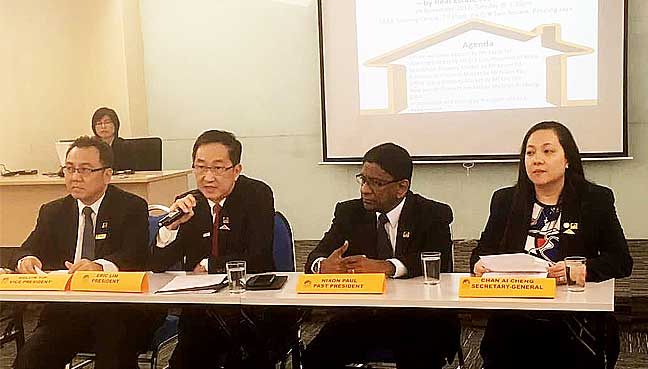
PETALING JAYA: The current property market is stable and moving at a moderate pace, with the outlook for next year expected to remain the same, the Malaysian Institute of Estate Agents (MIEA) said today.
Its president Eric Lim said this was concluded from the feedback and survey conducted among MIEA members and practitioners.
He said there had been a lot of speculation about a possible slump in the property market next year, and cautioned against overgeneralising the matter.
“We are on the ground. Our members are on the ground. We sell. We have a few hundred agents in the market. We know what is happening in the market. It is not fair to quote something when you are not in the market.
“The outlook for next year is generally quite stable. Maybe moving at a moderate pace. It depends on the location, the type, supply and demand.
“(The property market) is very subjective. It is not fair to say that a certain property is coming down. Some are going up, and some, maybe because there is too much supply, are not doing well, which in return may affect pricing.
“You cannot generalise in one sentence, to say that the property (market) will come down or if it is too good. That is how the property market is structured,” he told reporters after a press conference at its secretariat here today.
Also present were MIEA’s past president Nixon Paul, vice-president Kelvin Yip, and secretary-general Chan Ai Cheng.
Lim said the property market condition also depended on the location and type of property.
“People think there is one standard ruling, and I think it is not fair, because we are sensitive to the location and the type of development,” he said.
Lim said at present, property buyers were more savvy and prudent in managing their finances and investments, and more careful in their decision-making.
“The purchasing interest level in the market is still high, but is often dampened by the common frustration on loan issues.
“Most of the aborted transactions are due to either loan rejection or low margin of financing in both the primary and secondary properties,” he said.
Lim hoped that next year, banks would be more relaxed in their lending, and that the younger generation would be more creative in their borrowing.
He stressed the importance of embracing new technology to reach out to the Gen Y and millennials.
Lim also urged the government to extend support to the M40 group (middle income), on top of the government aid offered to those in the B40 category (bottom 40).
Thriving commercial property market
Paul also agreed that the property market should not be generalised, specifically in relation to the commercial property sector.
He listed down numerous commercial developments across the Klang Valley, in areas such as Bangsar, Bukit Damansara, SS2, Puchong, Sri Gombak, Damansara Perdana, Kota Damansara, Jalan Gasing and Setia Alam. He said some were new while some have been around for a considerable amount of time, but are all bustling.
In light of the thriving commercial market, Paul asked how it could be perceived as not doing well.
“When you take figures into totality, it is the wrong way to evaluate what is really happening on the ground.
“The commercial market is thriving and doing very well. The lack of transactions is because of a mismatch in value. Today, your purchasers are more informed and more serious. Information is readily available. You can Google almost anything.
“You cannot market property like how they used to 20 or 30 years ago. I think the sooner everyone accepts that, the more organised our property market will be,” he said in his presentation.
Citing small retail complexes such as the Tropics in Damansara Perdana and Cascades in Kota Damansara, which have low occupancy rates, Paul said the reason why such spaces were not doing well was because of differing rental values.
He added that there was no single body marketing the spaces or creating promotional activities to drive traffic there.
“To say there is an overhang is unfair. (It is just that) nobody is marketing it effectively,” he said, adding that in some other places, there were a lot of promotional activities which was why people kept going back there.
Paul said the reason transactions were slow for commercial properties was because there was no return on investment (ROI).
He said if an investor wanted to buy a commercial property, he would want to achieve a 5% return as he would have to pay the bank about 4.5%.
“All sellers are asking for inflated prices, so they cannot achieve 5%. If you cannot get that, you would not want to buy (the property),” he said.
Yip, meanwhile, said the volume and value of residential property transactions in selected states such as Selangor, Johor and Penang, had dropped, except for Kuala Lumpur, where the value of residential property increased by 12.7% in the first half of this year.
In terms of demand for condominiums or apartments, those within the price range of RM250,001 to RM500,000 and RM500,001 to RM1,00,001 were the most sought after.
“Given the lack of incentives and measures in Budget 2018 to spur the property segment, the overall outlook for the property market is expected to remain lacklustre going into the first quarter of next year,” he said in his presentation.
Chan meanwhile said the booking to sale conversion rate among buyers had seen a big improvement this year, from 50% last year to between 63% and 75% this year.
“This could be because buyers are more aware of the stringent requirements by the banks, being better prepared to own properties, knowing the cash requirement to purchase properties, and also they had time to work on improving their ‘loan-ability’ status.
“Buyers also do a lot of comparing, as they are more aware of what they want and what is available in the market,” she said.

